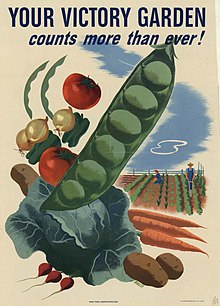Victory garden: Difference between revisions
| Line 5: | Line 5: | ||
== Background == |
== Background == |
||
Canned foods were rationed regularly in the United States., but the poster campaign ("Plant more in '44!") to plant a Victory Garden was answered by nearly 20 million Americans. These gardens produced up to 40 percent of all the vegetable produce that was consumed in the nation. Ideally, if [[home front]] urbanites and suburbanites could produce their own potatoes and carrots, mass-produced potatoes and carrots could be in larger supply, purchased more cheaply by the [[United States Department of War|War Department]] (saving pennies for bombers and tanks) and sent overseas to feed the troops: "Our food is fighting", one poster read. |
|||
Basic information about gardening appeared in public services booklets distributed by the [[United States Department of Agriculture|Department of Agriculture]], as well as by [[agribusiness]] corporations such as [[International Harvester]] and [[Beech-Nut]]. |
|||
[[Image:Sow_victory_poster_usgovt.gif|thumb|left|115px|WWI-era U.S. propaganda poster.]] |
|||
Victory gardens were planted in backyards and on apartment-building rooftops, with the occasional vacant lot "commandeered for the war effort!" and put to use as a cornfield or a squash patch. During World War II, sections of lawn were publicly plowed for plots in [[Hyde Park, London]] to publicize the movement. In [[New York City]], the lawns around vacant [[Riverside (house)|"Riverside"]] were devoted to victory gardens, as were portions of [[San Francisco, California|San Francisco's]] [[Golden Gate Park]]. |
|||
In 1946, with the war over, many residents did not plant Victory Gardens in expectation of greater produce availability. However the added pressures of supplying liberated Europe meant that, in the UK, shortages remained, or in many cases got worse. |
|||
== Films == |
== Films == |
||
Revision as of 21:52, 6 March 2007
The examples and perspective in this article may not represent a worldwide view of the subject. |

Victory gardens, also called war gardens or food gardens for defense, were vegetable, fruit and herb gardens planted at private residences in the United States, Canada, and United Kingdom during World War I and World War II to reduce the pressure on the public food supply brought on by the war effort. In addition to indirectly aiding the war effort these gardens were also considered a civil "morale booster" — in that gardeners could feel empowered by their contribution of labor and rewarded by the produce grown.
Background
Films
The United States Department of Agriculture issued a 20 minute film to promote and train people how to plant victory gardens, simply titled Victory Garden.
TV show
The successful WGBH public television series The Victory Garden, given wide distribution in the U.S. over the Public Broadcasting Service, took the familiar expression to promote composting and intensive cropping for homeowners who wanted to raise some vegetables (and some flowers). It has continued for over three decades.
See also
- Rationing in the United Kingdom during and after World War II
- Land Army
- Allotment (gardening)
- List of Allied propaganda films of World War II
External links
- PBS: The Victory Garden
- A history of Victory Gardening
- Victory Gardens Handbook of the Victory Garden Committee War Services, Pennslvania State Council of Defense (April 1944)
- Victory Garden complete film at archive.org
- Warner Brothers cartoon references
NOTE: Contemporary culture often carried War-oriented topical references, such as the Victory Garden, the V-for-Victory symbol, Rosie the Riveter, gasoline and meat rationing, etc., in addition to direct references to combat.cow
